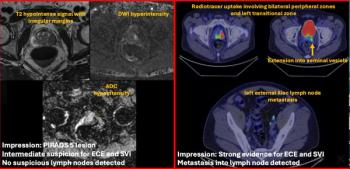
Alternatives to Measuring Breast Density Identified
Breast density can be measured using fully automated volumetric methods, which are less labor intensive than the commonly used methods.
Fully automated volumetric methods for measuring breast density are valid alternatives to the current gold standards, which may be more labor intensive, according to a study published in the journal
Researchers from the United Kingdom, New Zealand, the United States, France, and Singapore sought to validate the use of fully automated volumetric methods when screening for breast cancer using full-field digital mammography (FFDM).
The researchers assessed 3,168 FFDM images from 414 cases and 685 controls using three area-based approaches (BI-RADS, the semi-automated Cumulus, and the fully automated ImageJ-based approach) and three fully automated volumetric methods (Volpara, Quantra and single X-ray absorptiometry [SXA]). Linear regression models were used to assess associations between breast cancer risk factors and density among controls, and logistic regression models to assess density-breast cancer risk associations, adjusting for age, body mass index (BMI), and reproductive variables.
The results showed that the Quantra-based approach failed to produce readings for 4% of the subjects and the ImageJ-based approach failed in 11% of subjects.
All six density assessment methods showed that percent density was inversely associated with age and body mass index (BMI), and being parous and postmenopausal at mammography.
All methods produced positive associations of density with risk, but the association was highest for the fully-automated volumetric methods Volpara and Cumulus. The two also were alone in producing breast density measures for all images in the study. The researchers found that women with the highest density had 8.26 times the risk of those with the lowest breast density as measured by Volpara on this dataset, and it appeared that Volpara was more effective at identifying women at low risk.
“Mammographic density is one of the strongest risk factors for breast cancer and is increasingly being used to tailor preventive and screening strategies to a woman’s risk. It is also a major determinant of the sensitivity of mammographic screening and, by extension, the detection of interval cancers. Consequently, in many US states, it is now mandatory to inform screening-attendees of their density,” Dr. Isabel dos-Santos-Silva, professor of epidemiology, London School of Hygiene and Tropical Medicine, said in a release. “The results show that the mammographic density measurements yielded by automated volumetric measurements are as good predictors of breast cancer risk as those generated by well-established, but more labour-intensive methods such as Cumulus.”
The researchers concluded that the fully-automated methods were valid alternatives to the labor-intensive “gold standard” methods when quantifying density in FFDM. “The choice of a particular method will depend on the aims and setting,” they wrote. “But the same approach will be required for longitudinal density assessments.”
Newsletter
Stay at the forefront of radiology with the Diagnostic Imaging newsletter, delivering the latest news, clinical insights, and imaging advancements for today’s radiologists.




























